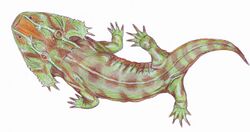Biology:Zatrachys
| Zatrachys | |
|---|---|

| |
| Zatrachys serratus | |
| Scientific classification | |
| Domain: | Eukaryota |
| Kingdom: | Animalia |
| Phylum: | Chordata |
| Class: | Amphibia |
| Order: | †Temnospondyli |
| Family: | †Zatracheidae |
| Genus: | †Zatrachys Cope, 1878 |
Zatrachys is an extinct genus of large and flat-headed zatracheidid temnospondyl from the early Permian of North America.
History of study
Zatrachys was named by American paleontologist Edward Drinker Cope in 1878 for the type species, Z. serratus, based on a partial skull from the early Permian of Texas.[1] Additional material has been reported from the early Permian of New Mexico[2][3] and Oklahoma.[4] Urban et al. (2007) reported material attributed to Z. serratus from the late Carboniferous and the early Permian of West Virginia.[5][6] This is the only record of Zatrachys in the Carboniferous.
Zatrachys microphthalmus[7] is now placed within Dasyceps.
Anatomy
Like all zatracheidids, Zatrachys is easily recognized by the presence of a large opening in the snout, the internarial fontanelle or fenestra. Of the three genera of zatracheidids, that of Zatrachys is the largest, extending as far back as to fully divide the nasals and to partially divide the frontals, a unique feature (autapomorphy). Other features that distinguish this genus are the presence of prominent spiky projections from the posterior skull (maxilla and quadratojugal), bosses and ridges on the lower jaw, a supratemporal that borders the otic notch, long and slender tabular horns and short postparietal horns, contact between the palatine and the vomer to fully enclose the choana on the palate, and a U-shaped skull profile intermediate to that of Acanthostomatops (broad and parabolic) and Dasyceps (elongate).
Although there are numerous reports of postcranial material attributed to Zatrachys, all of this was referred to species that are now reassigned to other temnospondyl taxa (e.g., "Zatrachys crucifer")[8] or material of other taxa that was mistakenly attributed to cranial material of Z. serratus due to close proximity during preservation (e.g., Platyhystrix). This often led to hypothesized close relationships with Platyhystrix in particular.
References
- ↑ Cope, E. D. (1878). Descriptions of extinct batrachia and reptilia from the Permian Formation of Texas /. Philadelphia?: American Philosophical Society. doi:10.5962/bhl.title.104569.
- ↑ Langston, Wann, Jr. (1966). Permian amphibians from New Mexico. University of California Publications in Geological Sciences. OCLC 663890737.
- ↑ Schoch, Rainer R. (1997-11-14). "Cranial anatomy of the Permian temnospondyl amphibian Zatrachys serratus Cope 1878, and the phylogenetic position of the Zatrachydidae" (in en). Neues Jahrbuch für Geologie und Paläontologie - Abhandlungen 206 (2): 223–248. doi:10.1127/njgpa/206/1997/223. ISSN 0077-7749.
- ↑ Olson, Everett C. (1965). "Zatrachys serratus Cope (Amphibia: Labyrinthodontia) from McClain County, Oklahoma". Oklahoma Geology Notes 25: 91–97.
- ↑ Urban, Michael; Berman, David S. (2007). "First occurrence of the late Paleozoic amphibian Zatrachys serratus (Temnospondyli, Zatrachydidae) in the eastern United States". Annals of Carnegie Museum 76 (3): 157–164. doi:10.2992/0097-4463(2007)76[157:FOOTLP2.0.CO;2].
- ↑ Lund, Richard (1976), "General Geology and Vertebrate Biostratigraphy of the Dunkard Basin", The Continental Permian in Central, West, and South Europe, Springer Netherlands, pp. 225–239, doi:10.1007/978-94-010-1461-8_19, ISBN 978-94-010-1463-2
- ↑ Cope, E. D. (1896). The reptilian order Cotylosauria. [publisher not identified]. OCLC 49637053.
- ↑ Case, E. C. (1903). "New or Little-Known Vertebrates from the Permian of Texas". The Journal of Geology 11 (4): 394–402. doi:10.1086/621084. ISSN 0022-1376. Bibcode: 1903JG.....11..394C.
Wikidata ☰ Q3267944 entry
 |

